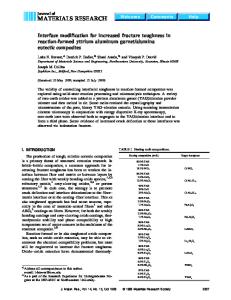Fracture Toughness of NiAl In-Situ Eutectic Composites.
- PDF / 4,383,275 Bytes
- 8 Pages / 420.48 x 639 pts Page_size
- 16 Downloads / 314 Views
FRACTURE TOUGHNESS OF NiAl IN-SITU EUTECTIC COMPOSITES. *
F. E. HEREDIA* and J.J. VALENCIA" Materials Department, University of California, Santa Barbara, CA 93106. ** Metalworking Technology, Inc., Johnstown, PA 15904.
ABSTRACT Mechanical tests were performed on directionally solidified (DS) NiAI in-situ eutectic composites in order to evaluate the effect of ductile reinforcements on the fracture resistance of the B2 ordered intermetallic compound NiAl. Reinforcements consisted of i) Mo fibers, ii) Cr fibers, and iii) Cr(Mo) solid solution plates. Near stoichiometric NiAl ingots were prepared by induction melting as reference material to compare with the eutectic composites. Resistance curves were obtained for the NiAl/Mo fibrous eutectic alloy as well as for the NiAl/Cr(Mo) layered material. The initiation fracture toughness of the DS NiAl/Mo and NiAl/Cr(Mo) eutectic composites is larger than that of the stoichiometric NiAl, with the layered material. producing the better properties. The mechanisms for such increase in fracture toughness are discussed. INTRODUCTION There has been a renewed interest during the last several years aimed to improve the ductility and fracture toughness of intermetallic alloys with potential as high temperature structural materials. One of these intermetallic compounds is the B2 NiA1. A well documented approach to improve the fracture resistance characteristics of such brittle intermetallics is by reinforcing them with ductile refractory metals [1-7]. Present understanding indicates the important effects of the flow strength and ductility of the refractory metal, its morphology and dimensions, as well as the interface debond resistance [5-10]. In the present study, two morphological classes of refractory reinforcement are investigated for the NiAl matrix, using materials produced by directional solidification [11-13]: i) NiAI/Mo and NiAl/Cr are used to provide a system with a continuous NiAl matrix, plus aligned rods of Mo or Cr reinforcement; ii) NiAl/Cr(Mo) is used to create a system with alternatinglayers of NiAl and Cr(Mo). The fracture resistance of these materials is measured and related to microstructure. EXPERIMENTAL Stoichiometric NiAl alloys of nominal compositions 45Ni-45Al-1OMo and 32.5Ni-32.5Al-35Cr (at%) were induction melted under a positive argon atmosphere in an A120 3 crucible and cast into copper molds to produce bars of 12.7 mm diameter. The cast bars were remelted under argon in a high purity A1203 crucible positioned inside a Bridgeman-type directional solidification apparatus. The melts were withdrawn from the heat zone of the directional solidification device at a rate of 3 cm per hour. The directionally solidified NiAl/Cr(Mo) eutectic material of nominal composition 32.5Ni-32.5A1-33Cr-1Mo (at%) was kindly provided by GE Aircraft Engines Division, Cincinnati, Ohio. This alloy was grown by the Edge-defined Film-Fed Growth (EFG) process at a rate of 10 cm per hour, producing slabs 25 mm wide and 3 mm thick [14]. Binary stoichiometric NiAl alloys were also induct
Data Loading...










